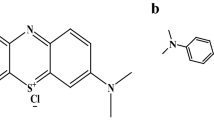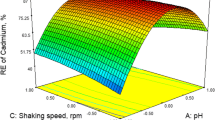Abstract
The effectiveness of low-cost biosorbent Blepharispermum hirtum for the removal of Zn(II) ions from aqueous solution was examined. To assess the impact of solution pH and temperature on biosorption capability, batch biosorption tests were conducted. The optimum conditions for biosorption were discovered at pH 6.0, 0.5 g/L of biomass, and 15 min of equilibrium duration. The biosorption data was well represented by Langmuir model with correlation coefficient of 0.9981 followed by Freundlich, Temkin and Dubinin--Radushkevich isotherms with the correlation coefficients of 0.9834, 0.9812 and 0.8790 respectively at a solution temperature of 303 K. According to the Langmuir isotherm model, the maximal adsorption capacities (qmax) for Zn(II) was 27.66 mg/g. The Fourier-transform infrared spectrometer (FTIR), X-ray diffraction (XRD) and scanning electron microscope (SEM) were used to carry out the characterization studies of biosorbent Blepharispermum hirtum. Discrete aggregates developed on the surface of the biosorbent because of interaction with metal ions. Either electrostatic attraction or a complexation mechanism held the metal ions to the biosorbents’ active sites.







Similar content being viewed by others
REFERENCES
Pellera, F.M., Giannis, A., Kalderis, D., Anastasiadou, K., Stegmann, R., and Wang, J.-Y., Adsorption of Cu(II) ions from aqueous solutions on biochars prepared from agricultural by-products, J. Environ. Manage., 2011, vol. 96, pз. 291–293.
Erto, A., Giraldo, L., Lancia, A., and Moreno-Pirajan, J.C., A comparison between a low-cost sorbent and an activated carbon for the adsorption of heavy metals from water, Water, Air, Soil Pollut., 2013, vol. 224, p. 1531.
Ibrahim, M.N., Wan Ngah, W.S., Norliyana, M.S., Daud, W.R., Rafatullah, M., and Sulaiman, O., A novel agricultural waste adsorbent for the removal of zinc(II) ions from aqueous solutions, J. Hazard. Mater., 2010, vol. 182, pp. 377–385.
Owamah, H.I., Biosorptive removal of Pb(II) and Cu(II) from wastewater using activated carbon from cassava peels, J. Mater. Cycles Waste Manage., 2013, vol. 16, pp. 347–358.
Al-Haidary, A.M.A., Zanganah, F.H.H., Al-Azawi, S.R.F., Khalili, F.I., and Al-Dujaili, A.H., A study on using date palm fibers and leaf base of palm as adsorbents for Pb(II) ions from its aqueous solution, Water, Air, Soil Pollut., 2011, vol. 214, pp. 73–82.
Depci, T., Kul, A.R., and Onal, Y., Competitive adsorption of lead and zinc from aqueous solution on activated carbon prepared from Van apple pulp: Study in single-and multi-solute systems, Chem. Eng. J., 2012, vol. 200, pp. 224–246.
Fu, F. and Wang, Q., Removal of heavy metal ions from wastewaters: A review, J. Environ. Manage., 2011, vol. 92, pp. 407–418.
Hameed, B.H., Din, A.T.M., and Ahmad, A.L., Adsorption of Methylene Blue onto bamboo-based activated carbon: Kinetics and equilibrium studies, J. Hazard. Mater., 2007, vol. 141, pp. 819–825.
Yao, Z.Y., Qi, J.H., and Wang, L.H., Equilibrium, kinetic, and thermodynamic studies on the biosorption of Cu(II) onto chestnut shell, J. Hazard. Mater., 2010, vol. 174, pp. 137–143.
Utomo, H.D. and Hunter, K.A., Adsorption of divalent copper, zinc, cadmium and zinc ions from aqueous solution by waste tea and coffee adsorbents, Environ. Technol., 2006, vol. 27, pp. 25–32.
Amarasinghe, B.M.W.P.K. and Williams, R.A., Tea waste as a low-cost adsorbent for the removal of Cu and Pb from wastewater, Chem. Eng. J., 2007, vol. 132, pp. 299–309.
Akkaya, G. and Guzel, F., Bioremoval and recovery of Cu(II) and Pb(II) from aqueous solution by a novel biosorbent watermelon (Citrullus lanatus) seed hulls: Kinetic study, equilibrium isotherm, SEM and FTIR analysis, Desalin. Water Treat., 2013, vol. 51, pp. 7311–7322.
Duan, C., Zhao, N., Yu, X., Zhang, X., and Xu, J., Chemically modified kapok fiber for fast adsorption of Pb2+, Cd2+, Cu2+ from aqueous solution, Cellulose, 2013, vol. 20, pp. 849–860.
Andrabi, S.M., Sawdust of lam tree (Cordia africana) as a low-cost, sustainable and easily available adsorbent for the removal of toxic metals like Pb(ii) and Ni(ii) from aqueous solution, Eur. J. Wood Wood Prod., 2010, vol. 69, pp. 75–83.
Makeswari, M. and Santhi, T., Use of Ricinus communis leaves as a low-cost adsorbent for removal of Cu(II) ions from aqueous solution, Res. Chem. Intermed., 2013, vol. 40, pp. 1157–1177.
Shukla, P.M. and Shukla, S.R., Biosorption of Cu(II), Pb(II), Ni(II), and Fe(II) on alkali treated coir fibers, Sep. Sci. Technol., 2013, vol. 48, pp. 421–428.
Singha, B. and Das, S.K., Adsorptive removal of Cu(II) from aqueous solution and industrial effluent using natural/agricultural wastes, Colloids Surf., B, 2013, vol. 107, pp. 97–106.
Choi, W., Chung, S.G., Hong, S.W., Kim, D.J., and Lee, S.H., Environmentally friendly adsorbent for the removal of toxic heavy metals from aqueous solution, Water, Air, Soil Pollut., 2011, vol. 223, pp. 1837–1846.
Langmuir, I., The adsorption gasses on plane surface of glass, mica and platinum, J. Am. Chem. Soc. 1916, vol. 40, pp. 1361–1368.
Freundlich, H.M.F., Over the adsorption in solution, J. Phys. Chem., 1906, vol. 57, pp. 385–470.
Aharoni, C. and Ungarish, M., Kinetics of activated chemisorption. Part 2. The oriental models, J. Chem. Soc., Faraday Trans., 1977, vol. 73, pp. 456–464.
Santhi, T., Manonmani, S., and Smitha, T., Kinetics and isotherm studies on cationic dyes adsorption onto Annona squmosa seed activated carbon, Int. J. Eng. Sci. Technol., 2010, vol. 2, no. 3, pp. 287–295.
Wu, X.-W., Ma, H.-W., Yang, J., Wang, F.-J., and Li, Z.-H., Adsorption of Pb(II) from aqueous solution by a poly-elemental mesoporous adsorbent, Appl. Surface Sci., 2012, vol. 258 pp. 5516–5521.
García-Rosales, G. and Colín-Cruz, A., Biosorption of lead by maize (Zea mays) stalk sponge, J. Environ. Manage., 2010, vol. 91, pp. 2079–2086.
Puranik, P.R. and Paknikar, K.M., Biosorption of lead, cadmium, and zinc by Citrobacter strain MCMB-181: Characterization studies, Biotechnol. Prog., 1999, vol. 15, pp. 228–237.
Deepa, C. N., Jayadevappa, Suresha, S., Removal of Zn(II) ions from aqueous solution and industrial wastewater using leaves of Araucaria cookie, Arch. Appl. Sci. Res., 2013, vol. 5, no. 4, pp. 117–126.
Nageswara Rao, L., Adsorption of lead and zinc from aqueous solution using Terminilia catappa L. as an adsorbent, Int. J. Eng. Res. Sci. Technol., 2013, vol. 2, pp. 65–76.
Vinod, V., Kailash, D., Suresh, C., and Madan, L., Adsorption studies of Zn(II) ions from wastewater using Calotropis procera as an adsorbent, Res. J. Recent Sci., 2012, vol. 1 (ISC-2011), pp. 160–165.
Israel, U. and Eduok, U. M., Biosorption of zinc from aqueous solution using coconut (Cocos nucifera L.) coir dust, Arch. Appl. Sci. Res., 2012, vol. 4, no. 2, pp. 809–819.
Conrad, K. and Bruun Hansen, H.C., Sorption of zinc and lead on coir, Bioresour. Technol., 2006, vol. 23, pp. 121–126.
Mohan, D. and Singh K.P., Single-and multi-component adsorption of cadmium and zinc using activated carbon derived from bagasse—An agricultural waste, Water Res., 2002, vol. 36, pp. 2304–2318.
ACKNOWLEDGMENTS
The author is grateful to the HOS (Chemical Engineering), HOD (Department of Engineering), ADAA, and Dean of UTAS, Salalah, for their generous direction, help, and insightful recommendations, as well as for giving the infrastructural facilities to work, without which this work would not have been feasible.
Author information
Authors and Affiliations
Corresponding author
Ethics declarations
The author declares that he has no conflicts of interest.
About this article
Cite this article
Rakesh Namdeti Biosorption and Characterization Studies of Blepharispermum hirtum Biosorbent for the Removal of Zinc. J. Water Chem. Technol. 45, 367–377 (2023). https://doi.org/10.3103/S1063455X23040100
Received:
Revised:
Accepted:
Published:
Issue Date:
DOI: https://doi.org/10.3103/S1063455X23040100




